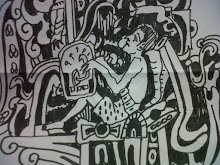Hauser

ONE EVENING in March 1908 , when Hauser had only just returned from a tour of inspection of the excavation sites, tired out and wet through, a workman belonging to the Le Moustier party called on him in great excitement, reporting that a human
bone had been discovered in a wholly untouched cultural layer of great antiquity.
Hauser immediately drove to the site, examined it by lantern light, and verified the workman's statement.
What chiefly agitated and fascinated him was the fact that the layer in the Le Moustier grotto must be some 250.000 years old. It wa unmistakably Acheulan. Apart from the Pithecantropus, so early an epoch had not yet yielded any primitive human remains whatever.
Almots any investigator in Hauser's situation would have instantly proceeded to further excavations, in a flurry of eagerness to ascertain what the prehistoric man of Le Moustier must have looked like and whether any more relics of him were to be found.
Hauser was faced with a difficult decision. Would he not once more be reproached with impropriety, and would not his statements once more he doubted, if he started digging into the hitherto untouched layer with no witnesses ? He pulled himself together. Then he ordered a great heap of earth to be piled on the site of the find, sentries to be posted, and every possible measure to be taken to ensure the security of the all important spot. He did not touch the bone.
He spent the following weeks sending out invitations to French and German experts, in whose presence he intended to uncover the site and have every phase of the excavation photographed and recorded in writing. The first to arrive was a delegation of the French government.
It verified Hauser's statement that the layer was untouched and established the fact that it contained a skull. Hauser again covered up the site, repressed his curiosity, and went on waiting.
The month was now August. Eventually, after Hauser had sent over six hundred invitations to professional people all over the world, a party of nine German scientists arrived to investigate the matter, with more suspicion than real interest. Among then were such great men as Klaatsch, Hans Virchow, the prehistorian Gustav Kossina, and the anthropologist Baelz, private physician to the emperor of Japan.
Klaatsch remained skeptical until Hauser with his own hands laid bare the vault of the skull. Then he noticed something . He examined the ridges over the eyes as they caught the light and finally exclaimed : " If the region of the jaws shows the same primitive characteristics, we are in the presence of the most important anthropological find that has ever been made !" He took over the work of excavation himself, with Hauser assiting him. Piece after piece of the decayed brittle skull and bones were exhumed from the soil and every tiny particle recorded. The camera came into action and registered all the stages of the work. The sun beat down on the site and hours passed. At last th eskull and skeleton lay exposed to the investigator's gaze. Klaatsch uttered a cry of delight. Shortly before setting out for Le Moustier he had prepared an imaginative reconstruction of Neanderthal man .
The bones before them resembled it in every detail. He embraced Hauser. "We've found it ! This is Neanderthal man in the full, the formidable bulk of his primitive frame !"
The Mousterian had been a youth of about fifteen, earlier in date and far better preserved than any member of the Neanderthal race hitherto submitted to science.
Labels: magazine


0 Comments:
Post a Comment
Subscribe to Post Comments [Atom]
<< Home